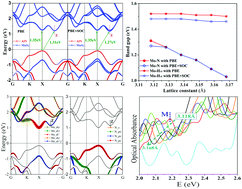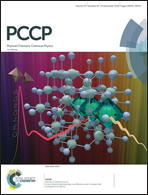Improved visible-light absorbance of monolayer MoS2 on AlN substrate and its angle-dependent electronic structures†
Abstract
In this paper, we performed density functional theory (DFT) calculations to investigate the geometric structures, electronic structures and visible-light absorbance of MoS2/AlN heterostructure based on van der Waals interaction. The calculated formation energy indicated that the designed MoS2/AlN heterostructure could be experimentally prepared. The Mo–N stacked MoS2/AlN heterostructure exhibited more considerable optical absorption in visible-light region than MoS2 and AlN monolayers. More interestingly, the band gaps were sensitive to strain, which led to an obvious shift of optical absorption spectra along the direction of the infrared region. The two most energetically favorable twisted MoS2/AlN heterostructures (Mo–N and Mo–HAl) had similar band structures, which were different from the non-twisted MoS2/AlN heterostructure. With different rotation angles, their band structures all exhibited an indirect band gap and almost had the same values of indirect band gaps, indicating that the indirect band gaps had no clear dependence on rotation angles.



 Please wait while we load your content...
Please wait while we load your content...